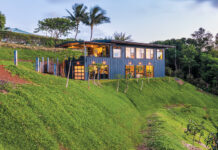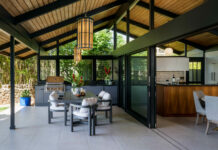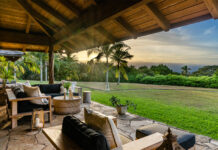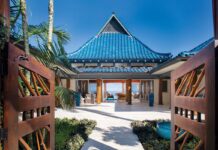Story by Diane Haynes Woodburn | Photography by Nina Lee | Art direction by Cecilia Fernandez Romero | Home Accessories courtesy of Pier 1 Imports
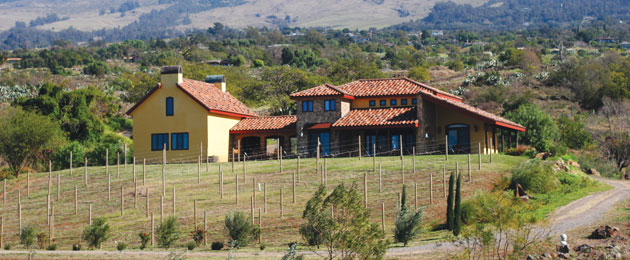 “It’s all about the harvest.” Alan Battersby’s face breaks into a smile of pride and delight. “We’ll have 100 friends and neighbors here. Everyone is invited.” He sweeps his arms in a magnanimous gesture, indicating the bucolic stretch of green in front of us. “The long lawn is for bocce ball and picnic tables. Kids will be running around everywhere. We’ll start with a huge breakfast—and then everyone will join in to pick.”
“It’s all about the harvest.” Alan Battersby’s face breaks into a smile of pride and delight. “We’ll have 100 friends and neighbors here. Everyone is invited.” He sweeps his arms in a magnanimous gesture, indicating the bucolic stretch of green in front of us. “The long lawn is for bocce ball and picnic tables. Kids will be running around everywhere. We’ll start with a huge breakfast—and then everyone will join in to pick.”
Alan and his wife, Lisena, are planning an olive harvest (not to be confused with the grape harvest, though that, too, will happen). And although the party won’t be till sometime this autumn, the vision in Alan’s mind couldn’t be more vivid. “By late afternoon I’ll have the pizza oven fired up and ready—we’ll make all kinds, plus huge salads from the garden—and wine. Lots of wine. By then I should have another sixty bottles ready!”
No, we aren’t in Italy, although we certainly could be. In front of us, acres of olive trees and grapevines cover the rolling, sun-drenched hills; beyond them lies a spectacular ocean vista. Surely, this is how one would picture a Tuscan villa. But don’t let the charm and beauty fool you. This is a fully operational farmhouse. The small home overlooks seventeen acres of Kula farmland. “We have over nine acres currently planted in nineteen varieties of olive trees and three varieties of grapes. And we’re just getting started,” says Battersby.
We’ve gathered for a pizza party on the back lawn. Low rock walls are dotted with herbs and flowers, including lavender, Italian parsley, rosemary, basil, and bright orange nasturtiums. The aroma from the pizza oven is intoxicating: fresh bread, garden herbs, cheese and prosciutto. It’s a love story of food, wine and gorgeous countryside. At this 2,000-foot elevation, the climate is cool, but the sun is bright and warming. We feel as if we are visiting a villa that is centuries old, but in reality, it’s still in the final stages of completion—a completion that marks a beginning of a lifestyle that, until very recently, the Battersbys had not even dreamed of embracing.
“This was never the plan,” Alan confesses. Both he and Lisena are Italian by heritage, and love to travel, particularly to Italy. Their business of buying and selling boutique hotels has afforded them the opportunity to see the world and to own homes in the Pacific Northwest and Hawai‘i. “We never really lived in our homes before our daughter was born. When the weather changed, we chased the sun.” But when Isabella arrived premature, her continuing health needs prohibited travel. “So we thought, why not bring Italy here?” More than that, the Battersbys wanted to plant roots, literally.
“When we first found the land, I spent many hours with Hans Kundelatsch, our neighbor up the road [who also sold them the property]. Although Hans is German by heritage, he spent many years in Italy. He would share a bottle of wine with me, and [tell] stories about his life in the Old Country. It was he who told me the soil in Kula was exactly the same as the soil in Sicily. That’s what gave me the idea we could grow grapes and olives.
“We are trying to emulate what our grandparents did. We’re trying to go backwards, to use less energy, downsize, have less.”
Battersby shared his vision with Seattle architect Steve Tapp, and without a hitch, what had once been plans for a Hawaiian-style home transformed into a Tuscan villa. Ceilings 30 feet high give the home’s small footprint (only 900 square feet) a massive feeling, and room for a second level for storing wine. Huge, heavy wooden doors and tall, wood-framed, arched windows add artistry to an otherwise simple design. The pitched roof also evokes old Italy, using semi-cylindrical terracotta tiles and wide, overhanging eaves. “We put small pockets of concrete under the tiles to make it look authentic,” Battersby explains. “That’s how they did it in the old days.” Another special touch is the copper “bishop hats” that cover the chimneys. Eventually the copper sheen will weather to verdigris.
An arched breezeway connects the home to the processing room—a barnlike structure where the wine is made and stored. Soon it will house an olive press, as well. On the other side of the house, just off the bedroom, a bathtub carved from a single solid stone is situated in a private garden, overlooking the olive groves and grapes. The stuccoed walls are painted a rustic yellow/orange, producing a decidedly Mediterranean silhouette against the blue sky.
Battersby is especially proud that the home was built using exclusively local artisans and contractors, and all materials were sourced from Hawai‘i companies as well. “We have such an incredible pool of talented people right here,” he says, “there’s absolutely no need to import help at any level.” And, he promises, the home will remain off the grid, using solar energy.
Battersby also hired an agricultural consultant, who advised him to plant all kinds of vegetables, citrus, coffee, olives and grapes. Today three varieties of grapes thrive here: sangiovese, primarily for Chianti; cabernet sauvignon, the workhorse grape; and merlot, which Battersby hopes will make a super Tuscan red wine. He’s also testing four new grapes: Barbera, pinot grigio, syrah and sauvignon blanc. “If they do well,” he tells me, “we’ll plant an additional eight acres.” This year he produced ninety bottles of his own wine. And it’s good. We’re savoring the fruit of his labor with our pizza, and enjoying every sip.
For this first production, Battersby brought in merlot juice from California to blend with his sangiovese grapes. The happy result is a very smooth and flavorful wine—with no additives. “Our wine is similar to the wine you would find at the small vineyards in Italy where they produce without preservatives, and it’s just beautiful to drink.” Because they neither export nor make wine in huge amounts, the Battersbys don’t need to add preservatives or sulfites. Next year, Battersby hopes to have his own merlot for a completely Maui-grown wine.
“We think olives and grapes are the next agriculture product for Maui,” Battersby says, “We see tremendous potential.” And the crop is environment friendly. Both grapes and olives are drought tolerant, requiring very little water to produce fruit.
As for the olives—the consultant was right. The three-year-old trees are already producing flowers. Battersby is testing nineteen varieties from Italy, Spain, Greece and France. Those doing the best are the Italian Pendolino and Frantoio, along with the Spanish Arbequina and the Greek Koroneiki. Four-hundred-fifty trees are currently planted, with another 450 propagated that will be ready to plant later this year, and another 2,000 that will be offered for sale the following year.
This fall will bring the first olive harvest. And, I’m told, it’s pretty easy to do. Olives (unlike grapes) are fairly easy to pick, and even easier to process. The fruit can be immediately fed into a crusher, and the subsequent oil is good the next day! Most oil is aged about thirty days, but that’s just so the solids drop and the oil becomes clear. Today, boutique oils have become so popular that many fine oils are sold fresh (and therefore cloudy).
“I can’t wait,” Battersby tell me,” an alchemist’s spark to his smile. “The harvest is a celebration of family and friends—a ritual that goes back to our very roots, back to what was important to our grandparents and their parents. We spent so many years acquiring; now we want to get back to what is real and important. Celebrating life and Earth’s abundance—that’s what this house is all about.”

